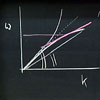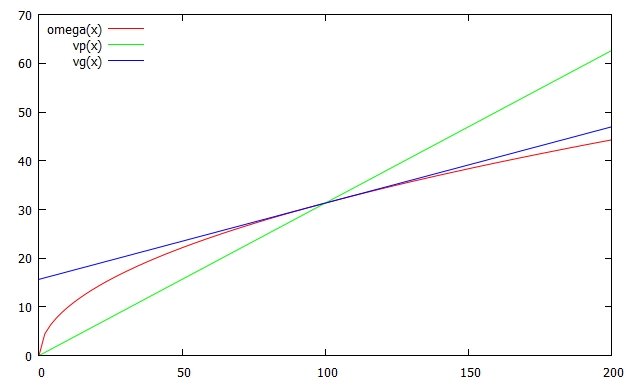-

-
Courses
Find courses by:
Collections
Cross-Disciplinary Topic Lists
- About
- Donate
- Featured Sites

 |
|
By the end of this lecture, you should:
› View/hide answer
With this wavelength, surface tension is unimportant and the water is deep compared to the wavelength Thus the dispersion relation is \(\omega = \sqrt {gk}.\) Since \( k = \frac{{2\pi }}{\lambda }\)we have \[k = \frac{{2\pi }}{{0.05}} = 126m^{-1}.\] In turn the frequency in Hz is \[\frac{\omega }{{2\pi }} = \frac{{\sqrt {gk} }}{{2\pi }} = \frac{{\sqrt {9.8(126)} }}{{2\pi }} = 5.6Hz.\] The ripples move at the phase speed which is \[{v_p} = \sqrt {\frac{g}{k}} = \sqrt {\frac{{9.8}}{{126}}} = 0.28 m/s\] (seems about right for those who have done this). The group speed is half this or \[{v_g} = 0.14 m/s. \] In \(\frac{5}{{.14}} = 36 s\) the pulse gets to the edge and since the boundary is free "a mountain comes back as a valley". After about one minute the pulse would get back to the middle and make a peak again.
› View/hide answer
The function to be plotted is \(\omega = \sqrt {gk} = \sqrt {9.8k} = 3.13\sqrt k.\) When \(k = 100, \omega = 31.3 rad/s.\) The phase speed is \(\frac{\omega }{k} = 0.313 m/s\), which is the slope of the line from the origin \(\omega = 0.313k\). The tangent line at that point has a slope which can be approximated graphically or calculated exactly using \({d\Omega/dk}\) which is \( 3.13/{2 \sqrt{k}} \) . When k=100, this gives 0.1565 m/s, exactly half the speed, so its equation is \[\omega = 31.3 + 0.1565(k - 100)\] All comes out looking consistent.
